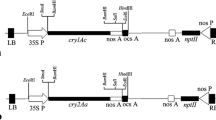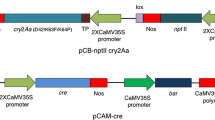Abstract
Solanum melongena (eggplant) cv. Picentia and the wild species Solanum integrifolium were transformed with both a wild type (wt) and four mutagenized versions of Bacillus thuringiensis (Bt) gene Bt43 belonging to the cry3 class. The Bt gene was partly modified in its nucleotide sequence by replacing four target regions (W: +1 to +170; X: +592 to+1057 ; Y: +1203 to +1376; Z: +1376 to +1984) with synthetic fragments obtained by polymerase chain reaction amplification of crude oligonucleotides. The synthetic Bt genes were designed to avoid, in their modified regions, sequences such as ATTTA sequence, polyadenylation sequences and splicing sites, which might destabilize the messenger RNA. Furthermore, the codon usage was improved for a better expression in the plant system. The amino acid composition was not altered. Four versions of the modified Bt gene were obtained, BtE, BtF, BtH and BtI, with a nucleotide subtitution percentage of 8.2, 8.6, 14, and 16%, respectively, in comparison to the wt gene Bt43. Modified versions contained different subsets of substituted regions: BtE - W+Z, BtF - Y+Z, BtH - X+Y+Z, BtI - W+X+Y+Z. In the final modified version (BtI), overall guanine + cytosine was increased from the 34.1% of the wt gene to 45.5%, and most of the destabilizing sequences were eliminated. Transgenic plants obtained with the more modified versions, BtH and BtI, were fully resistant to Leptinotarsa decemlineata Say first- and third- instar larvae, while Bt43 wt, BtE and BtF genotypes did not cause mortality and did not affect larval development.
Similar content being viewed by others
References
Adang MJ, Brody MS, Cardineau G, Eagan N, Roush RT, Shewmaker CK, Jones A, Oakes JV, McBride KE: The reconstruction and expression of a Bacillus thuringiensis cryIIIA gene in protoplasts and potato plants. Plant Mol Biol 21: 1131-1145 (1993).
Armstrong CL, Parker GB, Pershing JC, Brown SM, Sanders PR, Duncan DR, Stone T, Dean DA, DeBoer DL, Hart J, Howe AR, Morrish FM, Pajeau ME, Petersen WL, Reich BJ, Rodriguez R, Santino CG, Sato SJ, Schuler W, Sims SR, Stehling S, Tarochione LJ, Fromm ME: Field evaluation of European corn borer control in progeny of 173 transgenic corn events expressing an insecticidal protein from Bacillus thuringiensis. Crop Sci 35: 550-557 (1995).
Aronson AI, Beckman W, Dunn P: Bacillus thuringiensisand related insect pathogens. Microbiol Rev 50: 1-24 (1986).
Barton KA, Whiteley HR, Yang N-S: Bacillus thuringiensisδ-endotoxin expressed in transgenic Nicotiana tabacumprovides resistance to lepidopteran insects. Plant Physiol 85: 1103-1109 (1987).
Batt DB, Luo Y, Carmichael GG: Polyadenylation and transcription termination in gene constructs containing multiple tandem polyadenylation signals. Nucl Acids Res 22: 2811-2816 (1994).
Bevan M: Binary Agrobacteriumvectors for plant transformation. Nucl Acids Res 12: 8711-8721 (1984).
Chen Q, Jelenkovic G, Chin C-K, Billings S, Eberhardt J, Goffreda JC: Transfer and transcriptional expression of coleopteran CryIIIBendotoxin gene of Bacillus thuringiensisin eggplant. J Am Soc Hort Sci 120: 921-927 (1995).
Cheng J, Bolyard MB, Saxena RC, Sticklen MB: Production of insect resistant potato by genetic transformation with a δ-endotoxin gene from Bacillus thuringiensisvar. kurstaki. Plant Sci 81: 83-91 (1992).
Ciccarelli RB, Gunyuzlu P, Huang J, Scott C, Oakes FT: Construction of synthetic genes using PCR after automated DNA synthesis of their entire top and bottom strands. Nucl Acids Res 19: 6007-6013 (1991).
Dean C, Tamaki S, Dunsmuir P, Favreau M, Katayama C, Dooner H, Bedbrook J: mRNA transcripts of several plant genes are polyadenylated at multiple sites in vivo. Nucl Acids Res 14: 2229-2240 (1986).
Dellaporta SL, Wood J, Hichs JB: A plant DNA minipreparation: version II. Plant Mol Biol Rep 4: 19-21 (1983).
Ditta G, Stanfield S, Corbin D, Helinski DR: Broad host range DNA cloning system for Gram-negative bacteria: construction of a gene bank of Rhizobium meliloti. Proc Natl Acad Sci USA 77: 7347-7351 (1980).
Donovan WP, Rupar MJ, Slaney AC, Malvar T, Gawron-Burke MC, Johnson TB: Characterization of two genes encoding Bacillus thuringiensisinsecticidal crystal protein toxic to coleopteran species. Appl EnvironMicrobiol 58: 3921-3927 (1992).
Ebora RV, Ebora MM, Sticklen MB: Transgenic potato expressing the Bacillus thuringiensis CryIA(c) gene effects on the survival and food consumption of Phtorimaea operculella(Lepidoptera: Gelechiidae) and Ostrinia nubilalis(Lepidoptera: Noctuidae). J Econ Entomol 87: 1122-1127 (1994).
Fischoff DA, Bowdish KS, Perlak FJ, Marrone PG, McCormick SM, Niedermeyer JG, Dean DA, Kusano Kretzmer K, Mayer EJ, Rochester JG, Rogers SG, Fraley RT: Insect tolerant transgenic tomato plants. Bio/technology 5: 807-813 (1987).
Forgash AJ: Insecticide resistance of the Colorado potato beetle (Leptinotarsa decemlineataSay). In: Lashomb JH, Casagrande R (eds) Advances in Potato Pest Management (1981).
Fujimoto H, Itoh K, Yamamoto M, Kyozuka J, Shimamoto K: Insect resistant rice generated by introduction of a modified δ-endotoxin gene of Bacillus thuringiensis. Bio/technology 11: 1151-1155 (1993).
Gallie DR, Walbot V: Identification of the motifs within the tobaccomosaic virus 5′-leader responsible for enhancing translation. Nucl Acids Res 20: 4631-4638 (1992).
Grassi G, Mennella G, Moschella A, Onofaro V, Arpaia S, Iannacone R: Production of monoclonal antibody against recombinant protein obtained from Bacillus thuringiensisvar. San Diegotoxin gene active against colorado potato beetle (Leptinotarsa decemlineataSay). Proceedings of Microbial Control Agent in Sustainable Agriculture, Saint Vincent, 18-19 October, p. 178 (1995).
Green PJ: Control of mRNA stability in higher plants. Plant Physiol 102: 1065-1070 (1993).
Hofte H, Whiteley HR: Insecticidal crystal protein of Bacillus thuringiensis. Microbiol Rev 53: 242-255 (1981).
Jansens S, Cornelissen M, De Clercq R, Reynaerts A, Peferoen M: Phthorimaea operculella(Lepidoptera: Gelechiidae) resistance in potato by expression of the Bacillus thuringiensis Cry IA(b) insecticidal crystal protein. J Econ Entomol 88: 1469-1476 (1995).
Jefferson RA, Kavanagh TA, Bevan MW: Gus fusions: β-glucuronidase as a sensitive and versatile gene fusion marker in higher plants. EMBO J 6: 3901-3907 (1987).
Koziel GM, Beland GL, Bowman C, Carozzi NB, Crenshaw R, Crossland L, Dawson J, Desai N, Hill M, Kadwell S, Launis K, Lewis K, Maddox D, McPherson K, Meghji MR, Merlin E, Rhodes R, Warren GW, Wright M, Evola SV: Field performance of elite transgenic maize plants expressing an insecticidal protein derived from Bacillus thuringiensis. Bio/technology 11: 194-200 (1993).
Kruys V, Marinx O, Shaw G, Deschamps J, Huez G: Translational blockade imposed by cytokine-derived UA-rich sequences. Science 245: 852-855 (1989).
Malter JS: Identification of an AUUUA-specific messenger RNA binding protein. Science 246: 664-666 (1989).
McBride KE, Svab Z, Schaaf DJ, Hogan PS, Stalker DM, Maliga P: Amplification of a chimeric Bacillusgene in chloroplasts leads to an extraordinary level of an insecticidal protein in tobacco. Bio/technology 13: 362-365 (1995).
Murashige T, Skoog F: A revised medium for rapid growth and bioassays with tobacco tissue cultures. Physiol Plant 15: 473-497 (1962).
Murray EE, Lotzer J, Eberle M: Codon usage in plant genes. Nucl Acids Res 17: 477-498 (1989).
Murray EE, Rochelau T, Eberle M, Stock C, Sekar V, Adang M: Analysis of unstable RNA transcripts of insecticidal crystal protein genes of Bacillus thuringiensisin transgenic plants and electroporated protoplasts. Plant Mol Biol 16: 1035-1050 (1991).
Perlak FJ, Deaton RW, Armstrong TA, Fuchs RL, Sims SR, Greenplate JT, Fischhoff DA: Insect resistant cotton plants. Bio/technology 8: 127-134 (1990).
Perlak FJ, Fuchs RL, Dean DA, McPherson SL, Fischhoff DA: Modification of the coding sequence enhances plant expression of insect control protein genes. Proc Natl Acad Sci USA 88: 3324-3328 (1991).
Perlak FJ, Stone TB, Muskopf YM, Petersen LJ, Parker GB, McPherson SA, Wyman J, Love S, Reed G, Biever D, Fischhoff DA: Genetically improved potatoes: protection from damage by Colorado potato beetles. Plant Mol Biol 22: 313-321 (1993).
Prescott A, Martin C: A rapid method for the quantitative assessment of levels of specific mRNAs in plants. Plant Mol Biol Rep 4: 219-224 (1987).
Rotino GL, Arpaia S, Iannacone R, Iannamico V, Mennella G, Onofaro V, Perrone D, Sunseri F, Xike Q, Sponga S: Agrobacterium-mediated transformation of Solanumusing a Bacillus thuringiensisgene effective against Coleopteran. 8th Eucarpia Meeting ‘Genetics and breeding on Capsicum and Eggplant’ Rome, Italy, 7-10 September. Capsicum Newsl pp. 295-300 (1992).
Sambrook J, Fritsch EF, Maniatis T: Molecular Cloning: A Laboratory Manual, 2nd ed. Cold Spring Harbor Laboratory Press, Cold Spring Harbor, NY (1989).
Shaw G, Kamen R: Aconserved AU sequence from 3′ untranslated region of GM-CSF mRNA mediates selective mRNA degradation. Cell 46: 659-667 (1986).
Simpson CG, Brown JWS: Efficient splicing of an AU-rich antisense intron sequence. PlantMol Biol 21: 205-211 (1993).
Stiekema WJ, Heidekamp F, Louwerse JD, Verhoeven HA, Dijkhuis P: Introduction of foreign genes into potato cultivars Bintje and Désirée using an Agrobacterium tumefaciensbinary vector. Plant Cell Rep 7: 47-50 (1988).
Sutton DW, Havstad PK, Kemp JD: Synthetic cryIIIA gene from Bacillus thuringiensisimproved for high expression in plants. Transgen Res 1: 228-236 (1992).
Vaeck M, Reynarts A, Hofte H, Jansen S, De Beuckeleer M, Dean C, Zabeau M, Van Montagu M, Leemans J: Transgenic plants protected from insect attack. Nature 328: 33-37 (1987).
van Aarsen R, Soetaert P, Stam M, Dockx J, Gosselé V, Seurinck J, Reynaerts A, Cornelissen M: cryIA(b) transcript formation in tobacco is inefficient. Plant Mol Biol 28: 513-524 (1995).
van der Salm T, Bosch D, Honée G, Feng L, Munsterman E, Bakker P, Stiekema WJ, Visser B: Insect resistance of transgenic plants that express modified Bacillus thuringiensis cryIA(b) and cryIC genes: a resistance management strategy. Plant Mol Biol 26: 51-59 (1994).
Wilson T, Treisman R: Removal of poly(A) and consequent degradation of c-fos mRNA facilitated by 3′ AU-rich sequences. Nature 336: 396-399 (1988).
Wilson FD, Flint HM, Deaton WR, Fischhoff DA, Perlak FJ, Armstrong TA, Fuchs RL, Berberich SA, Parks NJ, Stapp BR. Resistance to cotton lines containing a Bacillus thuringiensis toxin to pink bollworm (Lepidoptera: Gelechiidae) and other insects. J Econ Entomol 85: 1516-1521 (1992).
Author information
Authors and Affiliations
Rights and permissions
About this article
Cite this article
Iannacone, R., Grieco, P.D. & Cellini, F. Specific sequence modifications of a cry3B endotoxin gene result in high levels of expression and insect resistance. Plant Mol Biol 34, 485–496 (1997). https://doi.org/10.1023/A:1005876323398
Issue Date:
DOI: https://doi.org/10.1023/A:1005876323398




